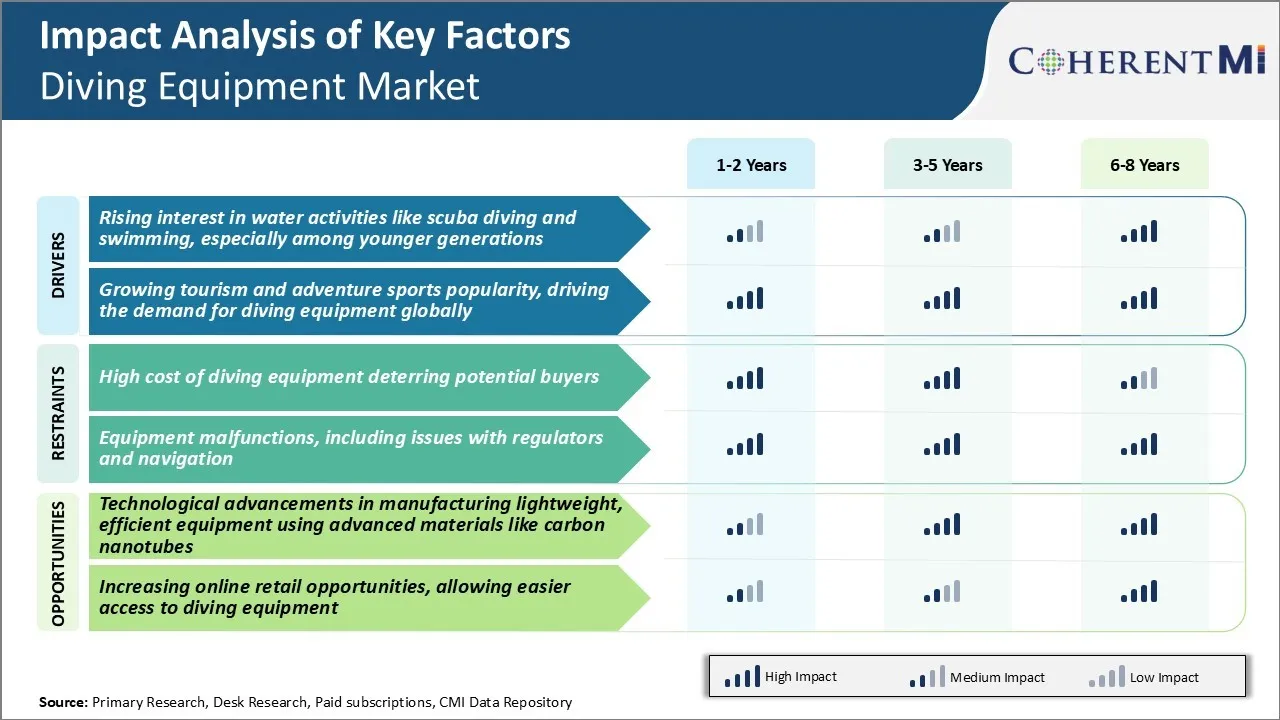Diving Equipment Market SIZE AND SHARE ANALYSIS - GROWTH TRENDS AND FORECASTS (2024 - 2031)
Diving Equipment Market is segmented By Product Type (BCD And Regulators, Cylinder and Diving Propul....
Diving Equipment Market Trends
Market Driver - Rising Interest in Water Sports among Younger Generations
The popularity of water sports and activities have been increasing substantially over the past decade. Younger people today are more interested in outdoor adventures and unique experiences compared to prior generations. Scuba diving in particular has emerged as one of the most pursued water activities nowadays.
This rising passion for scuba diving and similar water adventures has especially been prominent among Millennials and Generation Z consumers. Their adventurous spirit and preference for active lifestyles have drawn them towards these sports, which proves to be an important driver for the diving equipment market.
With greater exposure through online content and social media platforms, water adventures look increasingly appealing to younger audiences. Their desire to learn new skills and collect memorable experiences also motivates many to obtain scuba diving certifications. As incomes continue rising among professional youth, more are able to afford equipment and training for recreational diving.
Market Driver - Growing Tourism and Adventure Sports Boom
The tourism industry has shown strong growth globally in recent years. More travelers now want customized experiences rather than generic sightseeing. Adventure sports satisfying this demand have witnessed a significant boom. Activities involving water sports have grown in popularity as tourism destinations worldwide. Tropical island nations in particular have emerged as top scuba diving spots, which have seen strongly growing regional diving equipment markets.
As awareness about lesser-known locations increases, destinations across Asia, Africa, Latin America, and the South Pacific are also promoting their underwater offerings. Diving packages are now featured by many travel agencies and online travel portals. The desire to try unique watersports while on vacation has translated to rising equipment rental and purchase.
Features like GoPro cameras allow tourists to capture and share their underwater experiences easily. This serves to inspire more travelers to try scuba diving on tropical getaways. The booming tourism and adventure sports industry has crucially driven up diving equipment market globally.

Market Challenge - High Cost of Diving Equipment Deterring Potential Buyers
High costs of diving equipment have long been one of the biggest challenges facing the diving equipment market. Diving requires a considerable amount of specialized gear in order to ensure diver safety underwater, including wetsuits, regulators, BCDs, tanks, and more.
However, the cost of even basic entry-level equipment can easily exceed $1,000 once all necessary gear has been acquired. This high upfront investment acts as a substantial barrier to entry for many individuals interested in trying scuba diving or recreational diving as a hobby.
Many potential new divers are priced out of the diving equipment market before even making their first dive. Equipment manufacturers must make their products as affordable as possible in order to attract more casual recreational divers and grow the sport.
Lowering equipment prices could help open up diving to a much wider audience and democratize the diving equipment market. Instead, market leaders must focus on innovative designs and manufacturing technologies to reduce costs without compromising performance.
Market Opportunity - Technological Advancements in Manufacturing Lightweight, Efficient Equipment
One of the biggest opportunities for the diving equipment market is leveraging technological advancements to manufacture lighter, more durable gear using advanced new materials. Incorporating materials like carbon nanotubes into tanks, regulators and wetsuits promises to significantly reduce the weight and bulk of standard scuba setups.
Lighter diving equipment would not only be more comfortable for divers to wear and carry underwater, but could also encourage greater participation from individuals deterred by the physical demands of diving with conventional heavy gear. It may even allow certain equipment like BCDs and wings to be eliminated entirely.
Manufacturers that successfully adopt technologies like carbon nanotube composites will be able to offer divers high-performing, next-generation products at competitive price points. This could help strengthen brand loyalty while attracting a new generation of recreational divers that expect the latest innovative solutions from industry leaders.
Overall, materials science presents a major opportunity to revolutionize diving gear design and drive future of growth for the diving equipment market.